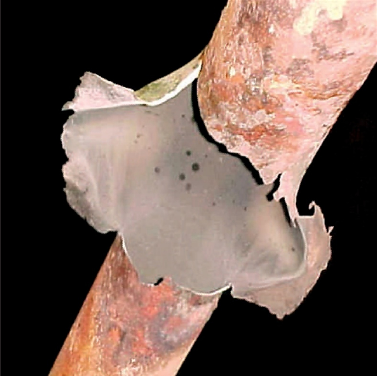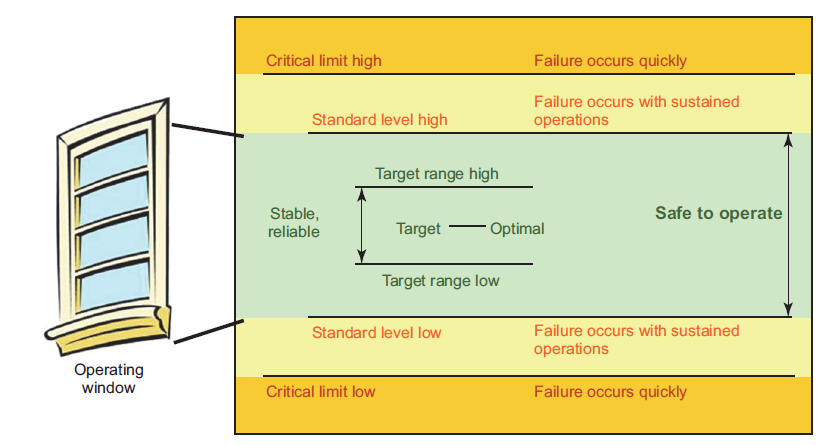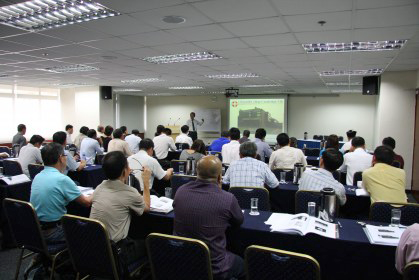|
Home | Consulting | Training | Expert Witness | Failure Analysis | Design Review | Corrosion Test | Corrosion Software | Protective Coatings | Materials Selection | Cathodic Protection | >>> | ||
|
Course Outline | Who Should Attend | Registration | In-House | On-Demand | Online Courses | PPT Slides+Testbank |Course List | Why WebCorr |
||
| Course Overview | ||
|
This 5-day corrosion short course is available for in-house training, on-site training, online and distance learning worldwide. It can also be customized to meet the specific needs of your organization.
|
||
|
||
| Course Outline | ||
|
1. Introduction to Integrity Operating Windows (IOWs)
2. Corrosion: Basic Concepts and Terminology
3. Basic Metallurgy and the Impact of Temperature on Microstructures and Mechanical Properties
3.1 Understanding the
Atomic Structure of Metals
4.1 Effect of
Temperature
5. Integrity Operating Widows: Work Process
6. Integrity Operating Widows: Risk Ranking
7. Examples of Integrity Operating Widows
9. General Considerations for Establishing IOWs and Their Limits
10. Documenting, Implementing, and Training on Established IOWs
11. Monitoring and Measuring IOW Parameters
12. Updating IOWs
13. Roles, Responsibilities, and Accountabilities for IOWs
14. Integrating IOWs with Other Related Work Processes
15. Examples of Potential Process Parameters for IOWs for Generic Process Units
17. Example of an IOW Development for a Heat Exchanger
18. Case Study: Implementation of IOWS in a gas processing plant
19.
Corrosion Prediction and Corrosion
Modeling Software for Calculation
and Verification of IOWs
O2Compass: Modeling and Prediction of High Temperature Oxidation and Creep Damage
NAC-Compass: Modeling and Prediction of High Temperature Naphthenic Acid Corrosion
CP-Compass: Cathodic Protection Design Calculations, Verification, Assessment and
Solutions
PipelineCompass: Pipeline Corrosion Modeling, Prediction, Assessment and Solutions
SC-Compass: Stray Current
Corrosion and AC Corrosion - Identification, Assessment and
Prediction
GC-Compass: Galvanic Corrosion Prediction and Materials Compatibility Assessment
CUI-Compass: Prediction and Risk Assessment of Corrosion Under Insulation and Fireproofing
Atmosphere-Compass: Prediction and Modeling of Atmospheric
Corrosion of Metals and Alloys 20. End-of-Course Examination
|
||
|
Course Outline |Who Should Attend |Registration |In-House |On-Demand |Online Courses |PPT Slides+Testbank |Course List |
||
| Who Should Attend | ||
|
Designers, engineers, inspection and maintenance personnel who are concerned with corrosion under insulation in the various industries such as chemical process, refining, petrochemical, power, onshore and offshore industries.
|
||
| Registration for This Corrosion Course | ||
|
|
||
| In-House Training Corrosion Courses/On-Site Training Corrosion Courses | ||
|
There is no minimum or maximum number of participants required for in-house training corrosion courses. We conduct the in-house training corrosion course at your company's premises and at a time convenient to your company.
Click here to contact us for a quotation.
|
||
| Corrosion Course-On-Demand | ||
|
Click here to contact us for a quotation for taking this course as course-on-demand.
|
||
| Online and Distance Learning Corrosion Courses | ||
|
Click here to register this corrosion short course for online or distance learning. |
||
| PowerPoint Slides and Test Banks for Trainers, Instructors, Tutors, University Lecturers and Professors | ||
|
If you are involved in teaching or training, you may wish to purchase a complete set of the trainer's package for this training course. The trainer's package comes complete with ready-to-use PowerPoint slides (fully editable) and test bank (with answer keys). These ready-to-use PowerPoint slides contain high quality color photographs, illustrations, animations, audio and video clips. The test bank contains questions conveniently grouped into four categories: (1) true or false, (2) multiple choice, (3) calculation, and (4) reasoning and open-ended discussions. The trainer's package is suitable for in-house training and university teaching (30 lecture hours). This is exactly the same package that WebCorr uses to deliver our current training course. The one-time lump sum fee allows your organization to use the training package and also modify it. For example, your organization may modify the course contents and re-name/re-brand the course under your organization’s name. WebCorr only retains the copyright of the original PowerPoint slides and test banks.
Click here to contact us if you need more information on the trainer's package. |
||
|
Course Outline |Who Should Attend |Registration |In-House |On-Demand |Online Courses |PPT Slides+Testbank |Course List |
||
|
Copyright © 1995-2024 WebCorr Corrosion Consulting Services. All rights reserved. |
||
 Corrosion
is defined in the ASTM G193 standard as “the deterioration of a
material, usually a metal, that results from a chemical or
electrochemical reaction with its environment”. The 66 damage mechanisms
described in API 571 are either due to metallurgical and
micro-structural changes occurring at high operating temperatures (high
temperature corrosion) or the changes in chemistry such as pH,
concentration of corrosives, fluid velocity at low/ambient temperatures
(aqueous corrosion). For process safety, a set of critical operating
ranges and limits must be established for key process variables. The
establishment, implementation, and maintenance of integrity operating
windows (IOWs) are essential for maintaining the integrity and reliability of
pressure equipment. This 5-day advanced course aims to (1) provide
participants with a clear and thorough understanding of why and how
operating variables affect the metallurgical, microstructural,
mechanical, and corrosion resistant properties of common alloys; (2) to
explain the common damage mechanisms encountered in the refining, petrochemical,
and process industries; (3) to explain the importance of integrity
operating windows (IOW’s) for process safety management, and (4) to
guide users in how to establish and implement an IOW program for the
refining, petrochemical, and process facilities. A number of the
Corrosion
is defined in the ASTM G193 standard as “the deterioration of a
material, usually a metal, that results from a chemical or
electrochemical reaction with its environment”. The 66 damage mechanisms
described in API 571 are either due to metallurgical and
micro-structural changes occurring at high operating temperatures (high
temperature corrosion) or the changes in chemistry such as pH,
concentration of corrosives, fluid velocity at low/ambient temperatures
(aqueous corrosion). For process safety, a set of critical operating
ranges and limits must be established for key process variables. The
establishment, implementation, and maintenance of integrity operating
windows (IOWs) are essential for maintaining the integrity and reliability of
pressure equipment. This 5-day advanced course aims to (1) provide
participants with a clear and thorough understanding of why and how
operating variables affect the metallurgical, microstructural,
mechanical, and corrosion resistant properties of common alloys; (2) to
explain the common damage mechanisms encountered in the refining, petrochemical,
and process industries; (3) to explain the importance of integrity
operating windows (IOW’s) for process safety management, and (4) to
guide users in how to establish and implement an IOW program for the
refining, petrochemical, and process facilities. A number of the

 If you are concerned with corrosion in your
business, in-house training or on-site training is a great solution to train a group of
employees from design, production, operation, quality assurance, inspection
and maintenance, and technical sales and support on corrosion control and
corrosion prevention technology. The contents of all corrosion courses can
be customized to fit your organization's needs.
If you are concerned with corrosion in your
business, in-house training or on-site training is a great solution to train a group of
employees from design, production, operation, quality assurance, inspection
and maintenance, and technical sales and support on corrosion control and
corrosion prevention technology. The contents of all corrosion courses can
be customized to fit your organization's needs.
 All our publicly scheduled corrosion short courses are conducted once a year. However, you do not need to wait for one year if you have missed any of the publicly scheduled corrosion courses as we have this unique corrosion course-on-demand scheme: we will conduct the course just for you on an one-on-one basis at a time and a location convenient to you. This option costs significantly less than a full-scale in-house training program.
All our publicly scheduled corrosion short courses are conducted once a year. However, you do not need to wait for one year if you have missed any of the publicly scheduled corrosion courses as we have this unique corrosion course-on-demand scheme: we will conduct the course just for you on an one-on-one basis at a time and a location convenient to you. This option costs significantly less than a full-scale in-house training program. All our corrosion short courses are
available for online or offline distance learning. You can start an
online course at any time and learn at your
own comfortable pace, whenever and wherever you are. You have around-the-clock
access to interactive and media-rich course materials, virtual labs, course
instructions, course assignments, and course assessments. Discussions and questions related to the corrosion courses
are posted on the website or exchanged through email for a period up to 3 months. Video conferencing or instant messaging can also be arranged for discussions of course topics.
For those who do not have ready access to internet, we can send
you our online course materials on a CD-ROM or DVD or USB memory stick for offline learning.
All our corrosion short courses are
available for online or offline distance learning. You can start an
online course at any time and learn at your
own comfortable pace, whenever and wherever you are. You have around-the-clock
access to interactive and media-rich course materials, virtual labs, course
instructions, course assignments, and course assessments. Discussions and questions related to the corrosion courses
are posted on the website or exchanged through email for a period up to 3 months. Video conferencing or instant messaging can also be arranged for discussions of course topics.
For those who do not have ready access to internet, we can send
you our online course materials on a CD-ROM or DVD or USB memory stick for offline learning.